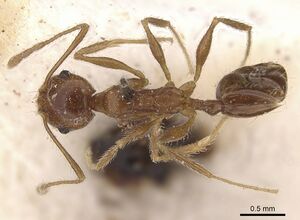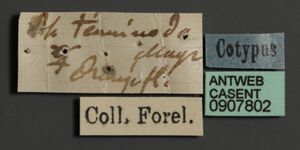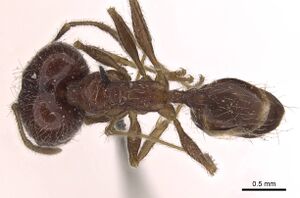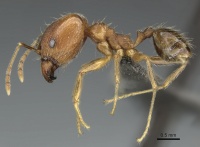Pheidole tenuinodis
| Pheidole tenuinodis | |
|---|---|

| |
| Scientific classification | |
| Kingdom: | Animalia |
| Phylum: | Arthropoda |
| Class: | Insecta |
| Order: | Hymenoptera |
| Family: | Formicidae |
| Subfamily: | Myrmicinae |
| Tribe: | Attini |
| Genus: | Pheidole |
| Species: | P. tenuinodis |
| Binomial name | |
| Pheidole tenuinodis Mayr, 1901 | |
| Subspecies | |
| |
Apparently widely distributed in eastern and southern Africa. In Benin, Taylor et al. (2018) report this species from mango (Mangifera indica) orchards, and as prey of Oecophylla longinoda. A Namibia saltpan baiting study found Ocymyrmex micans, Pheidole tenuinodis and a Tetramorium sp. were the behaviorally and numerical dominant ant species in this habitat. It is ground nesting.
Identification
Distribution
Latitudinal Distribution Pattern
Latitudinal Range: -13.75° to -32.36667°.
| North Temperate |
North Subtropical |
Tropical | South Subtropical |
South Temperate |
- Source: AntMaps
Distribution based on Regional Taxon Lists
Afrotropical Region: Benin, Cameroun, Namibia, South Africa (type locality).
Distribution based on AntMaps
Distribution based on AntWeb specimens
Check data from AntWeb
Countries Occupied
| Number of countries occupied by this species based on AntWiki Regional Taxon Lists. In general, fewer countries occupied indicates a narrower range, while more countries indicates a more widespread species. |

|
Estimated Abundance
| Relative abundance based on number of AntMaps records per species (this species within the purple bar). Fewer records (to the left) indicates a less abundant/encountered species while more records (to the right) indicates more abundant/encountered species. |

|
Biology
Castes
Worker
Minor
Images from AntWeb
   
| |
| Worker. Specimen code casent0235969. Photographer Estella Ortega, uploaded by California Academy of Sciences. | Owned by AFRC, Pretoria, South Africa. |
   
| |
| Syntype of Pheidole tenuinodis. Worker. Specimen code casent0907802. Photographer Will Ericson, uploaded by California Academy of Sciences. | Owned by MHNG, Geneva, Switzerland. |
Major
Images from AntWeb
   
| |
| Syntype of Pheidole tenuinodis. Worker (major/soldier). Specimen code casent0907801. Photographer Z. Lieberman, uploaded by California Academy of Sciences. | Owned by MHNG, Geneva, Switzerland. |
Nomenclature
The following information is derived from Barry Bolton's Online Catalogue of the Ants of the World.
- tenuinodis. Pheidole tenuinodis Mayr, 1901b: 10 (s.w.) SOUTH AFRICA. Arnold, 1920a: 430 (q.). Current subspecies: nominal plus bothae, robusta, sipapomae.
Description
References
- Arnold, G. 1920a. A monograph of the Formicidae of South Africa. Part IV. Myrmicinae. Ann. S. Afr. Mus. 14: 403-578 (page 430, queen described)
- Campbell, H., M. D. E. Fellowes, and J. M. Cook. 2015. Species diversity and dominance-richness relationships for ground and arboreal ant (Hymenoptera: Formicidae) assemblages in Namibian desert, saltpan, and savannah. Myrmecological News. 21:37-47.
- Gomez, K., Hawkes, P.G., Fisher, B.L. 2023. Ant endemicity in the highlands and escarpments of Angola and Namibia (Hymenoptera, Formicidae). Monograph on Endemism in the Highlands and Escarpments of Angola and Namibia. Namibian Journal of Environment 8, 197-203.
- Mayr, G. 1901b. Südafrikanische Formiciden, gesammelt von Dr. Hans Brauns. Ann. K-K. Naturhist. Mus. Wien 16: 1-30 (page 10, soldier, worker described)
- Ruano, F., Tinaut, A., Soler, J.J. 2000. High surface temperatures select for individual foraging in ants. Behavioral Ecology 11, 396-404.
- Taylor, B., Agoinon, N., Sinzogan, A., Adandonon, A., Kouaguou, Y. N., Bello, S., Wargui, R., Anato, F., Ouagoussounon, I., Houngbo, H., Tchibozo, S., Todjihounde, R., Vayssieres, J.F. 2018. Records of ants (Hymenoptera: Formicidae) from the Republic of Benin, with particular reference to the mango farm ecosystem. Journal of Insect Biodiversity 8(1): 6-29 (doi:10.12976/jib/2018.08.1.2).
References based on Global Ant Biodiversity Informatics
- Arnold G. 1920. A monograph of the Formicidae of South Africa. Part IV. Myrmicinae. Annals of the South African Museum. 14: 403-578.
- Braet Y., and B. Taylor. 2008. Mission entomologique au Parc National de Pongara (Gabon). Bilan des Formicidae (Hymenoptera) recoltes. Bulletin S. R. B. E./K.B.V.E. 144: 157-169.
- Campbell H., M. D. E. Fellowes, and J. M. Cook. . Species diversity and dominance-richness relationships for ground and arboreal ant (Hymenoptera: Formicidae) assemblages in Namibian desert, saltpan, and savannah. Myrmecological News 21: 37-47.
- Dean, W. R. J. and Bond, W. J. 1990. Evidence for Rapid Faunal Changes on Islands in a Man-Made Lake. Oecologia. 83:388-391.
- Forel A. 1910. Zoologische und anthropologische Ergebnisse einer Forschungsreise im westlichen und zentralen Südafrika ausgeführt in den Jahren 1903-1905 von Dr. Leonhard Schultze. Vierter Band. Systematik und Tiergeographie. D) Formicidae. Denkschriften der Medizinisch-Naturwissenschaftlichen Gesellschaft zu Jena 16: 1-30.
- Forel A. 1913. Fourmis de Rhodesia, etc. récoltées par M. G. Arnold, le Dr. H. Brauns et K. Fikendey. Annales de la Société Entomologique de Belgique 57: 108-147.
- Hanrahan S. A., M. J. Steinbauer, and F. D. Duncan. 2014. Ant assemblages in a poorly sampled part of the arid Nama Karoo. African Entomology 22(2): 448453.
- IZIKO South Africa Museum Collection
- Koch F., and K. Vohland. 2004. Ants along a southern African transect - a basis for biodiversity change monitoring (Insecta, Hymenoptera, Formicidae). Zoosystematics and Evolution 80(2): 261-273.
- Marsh A. C. 1985. Forager abundance and dietary relationships in a Namib Desert ant community. S. Afr. J. Zool. 20: 197-203.
- Marsh A. C. 1986. Ant species richness along a climatic gradient in the Namib Desert. Journal of Arid Environments 11: 235-241.
- Prins A. J. 1963. A list of the ants collected in the Kruger National Park with notes on their distribution. Koedoe 6: 91-108.
- Prins A. J. 1964. Revised list of the ants collected in the Kruger National Park. Koedoe 7: 77-93.
- Robertson H. G. 2000. Formicidae (Hymenoptera: Vespoidea). Cimbebasia Memoir 9: 371-382.
- Stitz H. 1923. Hymenoptera, VII. Formicidae. Beiträge zur Kenntnis der Land- und Süsswasserfauna Deutsch-Südwestafrikas 2: 143-167.
- Taylor B., N. Agoinon, A. Sinzogan, A. Adandonon, Y. N'Da Kouagou, S. Bello, R. Wargui, F. Anato, I. Ouagoussounon, H. Houngbo, S. Tchibozo, R. Todjhounde, and J. F. Vayssieres. 2018. Records of ants (Hymenoptera: Formicidae) from the Republic of Benin, with particular reference to the mango farm ecosystem. Journal of Insect Biodiversity 8(1): 006–029.
- Wheeler W. M. 1922. Ants of the American Museum Congo expedition. A contribution to the myrmecology of Africa. VIII. A synonymic list of the ants of the Ethiopian region. Bulletin of the American Museum of Natural History 45: 711-1004

